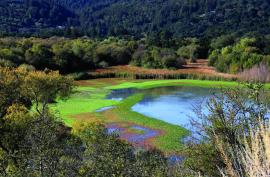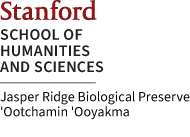Stewardship
At Jasper Ridge we engage in stewardship within the context of our academic research and teaching mission. This means understanding how stewardship protects and maintains important biodiversity and ecosystem attributes, but also influences the kinds of questions we can ask that help us understand how natural systems function and how humans interact with those systems.
An example are the protocols for collecting specimens. A researcher or class wanting to collect specimens for a particular purpose needs to demonstrate that the collecting will not have impacts that might disrupt the population in question or adversely impact the community. If the research question being pursued is deemed sufficiently important, then some impact may be deemed acceptable. This is always a difficult judgment, but we try and ensure protection by asking classes or researchers to justify collection in terms of why it should take place at Jasper Ridge and not someplace else.
Please see the philosophy tab for a more detailed explanation about how the preserve approaches conservation and protection.
The history of Jasper Ridge lands speaks to habitats and resources that reveal a long history of human intervention. That intervention helps frame how we think about stewardship and conservation.
Land use History
Jasper Ridge Biological Preserve has a long history of human influence. The preserve is located in the middle elevations of the San Francisquito Creek watershed, several areas of which have been excavated by Stanford archaeologists. Lower portions of the watershed outside JRBP include occupation sites of the local Native Americans, the Muwekma Ohlone, that date to more than 5,000 years ago; permanent year-round villages were established within JRBP that date to a later period, between 600 and 2000 years ago. The Muwekma Ohlone economy before European contact included hunting, fishing, harvesting of shellfish in the San Francisco Bay and on the Pacific coast as well as extensive collection of plant foods and materials and trade with neighboring tribes for highly prized raw materials and craft items. The Muwekma Ohlone were "complex hunter-gatherers" living in permanent settlements at a fairly high population density; this level of land use required extensive management of animal and plant resources, for example the use of fire to clear brush, encourage the growth of seed-bearing plants, and improve forage for game animals.
The arrival of Spanish soldiers and missionaries in the late 18th century disrupted the Muwekma Ohlone community, and the closing of mission properties after the U.S. annexation of California in 1846 scattered the remaining descendants into isolated "rancheria" settlements. Stanford archaelogists have collaborated closely with Muwekma Ohlone descendants since the founding of the university in the 1890's. The Muwekma Ohlone Tribe continues to participate in educational activities at Stanford University and JRBP.
Demand for lumber for missions and towns in the 1850's led to the establishment of sawmills adjacent to San Francisquito Creek and other nearby creeks. A small town, Searsville, sprang up nearby, but was short-lived, condemned in 1879 to make way for the construction of Searsville Dam. Most redwoods in the area of the present preserve were cut by the 1870's. Since then, the 389 ha central body of JRBP has remained largely undisturbed, except for grazing, which ended in 1960.
In the 1890's a local water company erected a dam below the confluence of four tributaries of San Francisquito Creek, forming Searsville Reservoir. The dam, reservior, and adjacent lands were purchased by Stanford University between 1892 and 1926, completing the University's holdings of the present preserve. For the next 50 years, the Searsville Lake area was managed by leaseholders as a recreational area, while scientific use intensified in the central portion of the preserve. Conflicts between the two uses developed and from 1956 to 1976, the Stanford Board of Trustees progressively afforded more protection to JRBP lands. In 1973, the Stanford Board of Trustees formally designated JRBP as a biological preserve and terminated the recreational activities at Searsville Lake in 1975.




